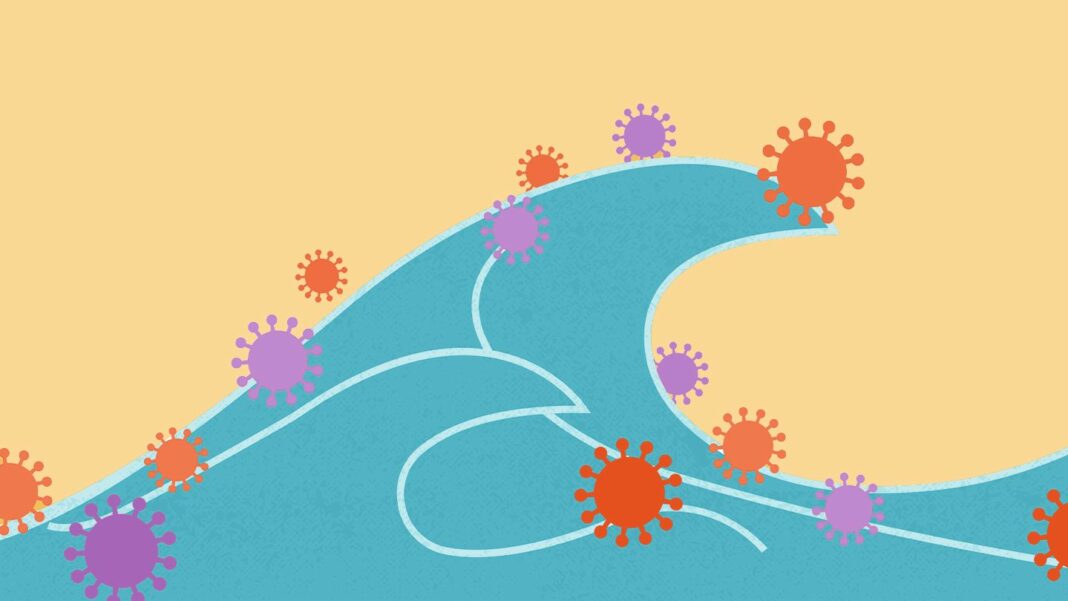Powered by the dominant new COVID-19 variant KP.3, a wave of summer COVID-19 infections may be upon us. But the size of that wave remains unknown.Wastewater (sewage) testing, which can provide an early warning signal that COVID-19 is increasing, has recently shown “very high” levels of viral activity in Florida, Hawaii, and Montana, and “high” levels in Alaska, California, Connecticut, Georgia, Maryland, and New Mexico, per the Centers for Disease Control and Prevention (CDC).[1]“As of June 11, 2024, we estimate that COVID-19 infections are growing or likely growing in 34 states and territories, declining or likely declining in one state or territory, and are stable or uncertain in 14 states and territories,” the CDC reported.[2]The CDC also noted that emergency department visits due to COVID-19 have risen by 12.6 percent over the week ending June 8.[3] But hospitalizations remain low.“We’ve seen a steady stream of people very sick with COVID but overall it’s still a handful,” says Peter Chin-Hong, MD, an infectious disease specialist affiliated with University of California San Francisco Medical Center. “Hospitalizations usually lag a little behind other COVID indicators, so I think we will see them increasing but not as much as in the past.”He adds that many severe illnesses are now often avoidable due to vaccines and treatments such as nirmatrelvir-ritonavir (Paxlovid), which prevent an infection from becoming serious.A New Variant Paves the Way for More InfectionsThe surge in new COVID activity appears to be due to the rise of a family of very contagious variants called FLiRT (short for the technical names of their specific mutations). These variants start with the letters “KP” or “JN,” and combined they currently account for more than two-thirds of cases in the United States.[4]The leader of the FliRT pack is a new strain called KP.3, which now makes up 25 percent of COVID cases, surpassing KP.2, which just weeks ago was the primary cause of COVID in the United States and now accounts for 22.5 percent of infections.“The difference between the two variants is an additional mutation within the spike protein,” says Dana Hawkinson, MD, medical director of infection prevention and control at the University of Kansas Health System in Kansas City. “It is believed this mutation helps to make binding to our cellular receptors a little bit easier. Overall KP.3 and KP.2 are very similar to each other, however. They are both variants from the JN.1 lineage.”While both strains appear to be highly contagious, Dr. Chin-Hong notes that it’s difficult to determine at this point if one is much more transmissible than the other. “The KPs are duking it out for who’s No. 1,” he says.The dominance of the FLiRT variations is influencing public health policymakers as they consider how the COVID vaccine should be reformulated moving forward.Last week, the U.S. Food and Drug Administration changed its recommendation that COVID-19 vaccines for the fall target JN.1, and instead suggested that the shots be designed to take on KP.2, if feasible.[5]“Regardless of which variant you pick to target, my feeling is that they’re all so related that you can’t go wrong with any one of these — they will still provide the main benefit, which is preventing hospitalization and death, particularly in the vulnerable,” says Chin-Hong.Be on the Lookout for COVID SymptomsThe CDC continues to warn about common COVID-19 symptoms such as congestion or runny nose, sore throat, fatigue, and headache.[6]Chin-Hong says he’s seeing fewer symptoms that were common in 2020, like shortness of breath and loss of taste and smell, and that some people are experiencing nausea and diarrhea — symptoms they may not realize can be linked to COVID.Because COVID-19 symptoms are often similar to those of allergies or the common cold, doctors warn that the only way to know for sure is to take a COVID test — especially if you are especially vulnerable to severe infection (if you are older, for instance, or are immunocompromised) and want to stave off serious disease with a course of Paxlovid. You should also test if you spend time with anyone at high risk whom you might infect.“I absolutely do think people dismiss COVID-19 symptoms as allergies or a summer cold,” says Dr. Hawkinson. “That is why, especially if you are at higher risk for severe disease, it is important to have a plan such as testing early for COVID-19, and possibly a couple days in a row.”Why a COVID Surge Now?By this time of year, many Americans may have received their last COVID shot months ago and their immunity may be wearing off somewhat, according to Chin-Hong. This may partially explain why COVID numbers are currently up.Warm weather is also a factor. While we think of winter as a time for viral spread, summer conditions increase transmission as well. When it’s hot and muggy outside, more people tend to gather indoors for the air conditioning, giving the virus a chance to transmit.Then there’s summer travel. Airlines for America forecasts U.S. airlines will carry 271 million passengers across the globe this summer, up 6.3 percent from last year.[7] This means more people congregating close together in airport terminals and airplane cabins, and a greater likelihood for disease spread.“People should be aware and vigilant but not scared,” says Chin-Hong. “Everyone, including immune-compromised people and older people, can navigate this surge very smoothly because of the availability of vaccines and antiviral drugs.”
